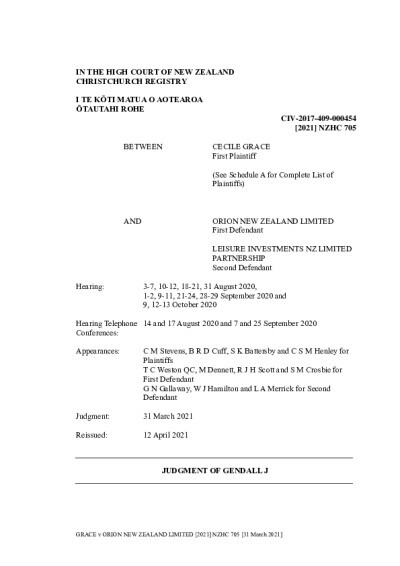
Date
Geographical Area
Pacific
Countries
New Zealand
Case Name
Grace & Ors v Orion New Zealand Ltd & Ors
Case Reference
[2021] NZHC 705
Name of Court
High Court of New Zealand
Key Facts
In February 2017, two major fires devastated properties in the Port Hills area over three days. The two fires (the Early Valley Road fire and the Summit Road fire) were started 4km apart on February 13th, 1.5 hours apart. The causes of the fires are not yet known.
On the 13th the Summit Road fire progressed into the Adventure Park. To avoid isolated fire damage to the haul rope, the Park continued to run their 1.8 km long four-seater chairlift which operated within a 12 metre corridor in the forest. Although the fire was largely contained by the afternoon of the 14th, on the 15th flames were evident around two of the chairlift towers. The decision was made to remove some of the chairs/bike carriers from the chairlift to avoid bunching at the top, however, only 30-35 of the 84 carriers were removed. Later on the 15th the flames were in the trees at a height above the chairlift line, meaning the flammable plastic chairs were passing through the burning forest. The chairs ignited, melted and dropped molten plastic onto the uncleared dry pine slash and erosion-preventing coconut matting below, causing spot fires along the line of the chairlift. These spot fires “developed rapidly”, merging to create a new front. This new front, and where it merged with the Early Valley Road fire, consumed nearby properties.
The plaintiffs acknowledged the Adventure Park did not cause the fire; however, they questioned the Park’s responsibility for the spread/outbreak of the fire within its property. They argued that the Park breached its obligations under the Forest and Rural Fires Act 1997, that their actions were negligent and committed a nuisance.
On the 13th the Summit Road fire progressed into the Adventure Park. To avoid isolated fire damage to the haul rope, the Park continued to run their 1.8 km long four-seater chairlift which operated within a 12 metre corridor in the forest. Although the fire was largely contained by the afternoon of the 14th, on the 15th flames were evident around two of the chairlift towers. The decision was made to remove some of the chairs/bike carriers from the chairlift to avoid bunching at the top, however, only 30-35 of the 84 carriers were removed. Later on the 15th the flames were in the trees at a height above the chairlift line, meaning the flammable plastic chairs were passing through the burning forest. The chairs ignited, melted and dropped molten plastic onto the uncleared dry pine slash and erosion-preventing coconut matting below, causing spot fires along the line of the chairlift. These spot fires “developed rapidly”, merging to create a new front. This new front, and where it merged with the Early Valley Road fire, consumed nearby properties.
The plaintiffs acknowledged the Adventure Park did not cause the fire; however, they questioned the Park’s responsibility for the spread/outbreak of the fire within its property. They argued that the Park breached its obligations under the Forest and Rural Fires Act 1997, that their actions were negligent and committed a nuisance.
Decision and Reasoning
Forest and Rural Fires Act 1997: Although they did not start the initial fire, the Court held that this was not necessary, as parties were also responsible under the Act for the outbreak/spread of a fire, not just its initial ignition. The Court found that the Park breached the Act by causing the ignition of a fire ahead of its initial ignition source, an act which they considered to be a new outbreak/spread. The Park could not avoid responsibility under the Act by claiming an extraordinary event as there had been “ample opportunity” to take steps to avoid the chairlift fire, they had failed to comply with their own Fire Safety Management Plan by not removing the pine slash, and the ignition of a fire due to molten plastic dropping onto slash and coconut matting was the logical/ordinary outcome of their actions. They also noted that the damage would not have occurred if not for the new outbreak, as the Summit Road fire was largely contained.
Negligence: The Court found it was fair and reasonable to impose a duty on the Park, and that this duty was owed to the plaintiffs as they were sufficiently proximate. They held that the Park had breached this duty, as a reasonable chairlift operator would have been aware that a major forest fire was likely to ignite the plastic chairs and that dropping molten plastic would cause fire, so would have removed all the chairs. Therefore, they had been negligent.
Nuisance: The Court also found the Park was liable in nuisance.
Negligence: The Court found it was fair and reasonable to impose a duty on the Park, and that this duty was owed to the plaintiffs as they were sufficiently proximate. They held that the Park had breached this duty, as a reasonable chairlift operator would have been aware that a major forest fire was likely to ignite the plastic chairs and that dropping molten plastic would cause fire, so would have removed all the chairs. Therefore, they had been negligent.
Nuisance: The Court also found the Park was liable in nuisance.
Outcome
As there was a causal nexus between the Park’s negligent actions and the loss, they were ordered to compensate the 80 plaintiff’s insurers for their losses, and the 80 plaintiffs for their uninsured losses, including an award of interest and costs. This was roughly NZ$12 million.
Link
Disclaimer
This case law summary was developed as part of the Disaster Law Database (DISLAW) project, and is not an official record of the case.
Document
Document